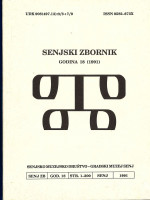NEPOSREDNI JEZIČNI DODIRI U HRVATSKIM DIJALEKTIMA U SAD
Direct Language Contact in Croatian Dialects in the USA
Author(s): Rudolf FilipovićSubject(s): Historical Linguistics, Comparative Linguistics, Sociolinguistics, South Slavic Languages, Translation Studies
Published by: Senjsko muzejsko društvo i Gradski muzej Senj
Keywords: Croatian Dialects; USA;
Summary/Abstract: The author's theory of Contact Linguistics (Filipović 1986) is based on the analysis of Anglicisms in European languages. The contact between English and any European language is indirect since it is established through an intermediary, either a third language or the mass media. In order to make a distinction between an indirect and a direct contact, the author presents the main principles of indirect language contact emphasizing one of the fundamental principles that the analysis of this type of contact can be carried out only on four levels (orthographic, phonological, morphological and semantic). However, the author's analysis of the contact between Croatian dialects in the U. S. and the American English shows that this contact is much closer and more intimate which results into the change of the conditions of transfer. In this kind of contact the borrowing language can also accept grammatical structures of the lending language which can influence the syntactic norm of the borrowing language. The new changes studied in the author's project "Croatian Dialects in the USA — Croatian-English Bilingualism" are the result of what the author calls a direct borrowing. The obvious conclusion of this analysis is that a direct borrowing can be analysed on five levels (one more than in an indirect borrowing) and that the syntactic level can be studied successfully on a corpus compiled from Croatian dialects in the USA.
Journal: Senjski zbornik - prilozi za geografiju, etnologiju, gospodarstvo, povijest i kulturu
- Issue Year: 18/1991
- Issue No: 1
- Page Range: 31-40
- Page Count: 10
- Language: Croatian

